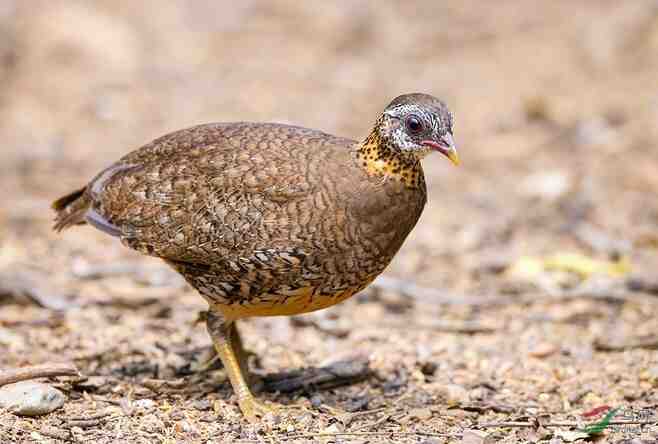Tropicoperdix chloropus
IUCN
LCBasic Information
Scientific classification
- name:Tropicoperdix chloropus
- Scientific Name:Tropicoperdix chloropus,Green-legged Partridge, Green-legged Hill-partridge, Scaly-breasted Partridge,Arborophila chloropus,Scaly-breasted Partridge, Green-legged Mountain Partridge
- Outline:Landfowl
- Family:Galliformes Phasianidae T.Partridge
Vital signs
- length:30cm
- Weight:250-300g
- lifetime:No verification information
Feature
The iris is reddish brown, the beak is horny yellow, and the feet are green
Distribution and Habitat
Origin: Cambodia, China, Myanmar, Thailand and Vietnam; breeding ground: Laos.
The green-footed tree partridge lives in mountain evergreen forests and shrubs at an altitude of 900-1500 meters. It is especially common in dense forests and forest shrubs in low mountains and foothills. It also moves in secondary forests and small jungles near farmland. It is also often seen in oat fields and sparse deciduous forests.
Appearance
The forehead, front of the eyes, and eyebrow of the green-footed tree partridge are white, and the inner vanes of the feathers are black; the top of the head to the nape of the neck are olive brown; the back is also olive brown, but the feathers are darker and have black end spots, forming wavy spots on the back. The lower back and waist have irregular black horizontal spots and the horizontal spots are mixed with brown-red. The inner coverts and flight feathers on the wings are the same color as the lower back. The outer coverts are light sandy brown with black spots; the secondary flight feathers are black-brown, and the outer vanes are mixed with brown and black-brown edges; the primary coverts and primary flight feathers are almost pure black-brown, and only the tips of the outer vanes are slightly mixed with small brown spots. The chin, throat and sides of the head are white and brown with black end spots; there is a rusty yellow collar with a slight black spot on the neck; the ch
Details
The green-footed tree partridge was previously classified as the mountain partridge genus (Arborophila) and was called the green-footed mountain partridge. Based on multi-gene sequence analysis, this species and the chestnut-breasted tree partridge (T. charltonii) should be classified as an independent tree partridge genus (Tropicoperdix).

Green-footed tree partridges often move in pairs or groups of 3-5. They are extremely timid and often hide under the forest, in the bushes or in the grass. They rarely take off and often move and run in the bushes and grass under the forest. When startled, they usually run a short distance, then crouch under cover such as bushes, and only take off suddenly when in a very dangerous situation. When active, they often call, and the call is high and rapid. The loud whistle includes a series of single notes, which get faster and faster, followed by a series of relatively flat rising and falling pitch changes, and finally a series of frantic rising and falling pitch changes and a sudden end.
When foraging, green-footed tree partridges often wander in pairs or small groups, digging through the leaf litter on the ground in the bushes to find insects and seeds for food. Usually only run a short distance, and then crouch under some cover. When startled, they suddenly take off and land on the ground not far away. They live mostly in mountain evergreen dense forests, mainly feeding on insects such as beetles and termites, small invertebrates, and plant seeds. They often forage in the leaf litter on the ground under the forest. Rest or drink water at the stream when it is hot at noon.
The breeding season of the green-footed tree quail is from April to June. The nest is built on the ground under the forest in the mountain forest between 1500-4000 meters above sea level, using natural pits on the ground or the female bird digging a small pit on the ground. The nest is often covered by lush bushes or understory plants and is not easy to find, but sometimes it is also built in places where the understory plants are sparse and not very hidden. The breeding situation of the green-footed tree quail is unknown. The female bird is mainly responsible for incubation, and the male bird is responsible for vigilance. Soon after hatching, the chicks can move with the parents.
The green-footed tree quail is only found in the tropical rain forest of Xishuangbanna, Yunnan. Since the late 1950s, the rainforest has been largely cleared for rubber tree planting, and the original natural landscape has been completely changed. In addition, a large number of plantation workers have moved in, built houses, planted vegetables, cut firewood for cooking, etc., which has further destroyed the forest. Therefore, the habitat of the green-footed tree partridge has been devastatingly destroyed. The global population size has not been quantified, but the green-footed tree partridge is described as a rare species in most of its range. It is rare and little known in China and is locally common in Thailand, Laos and Vietnam. The population is declining due to continued habitat destruction and unsustainable hunting levels.
Listed in the "IUCN Red List of Threatened Species" 2016 ver3.1-Least Concern (LC).
Listed in the "National Key Protected Wildlife List" of China (February 5, 2021) Level II.
Protect wild animals and stop eating game.
Maintaining ecological balance is everyone's responsibility!








